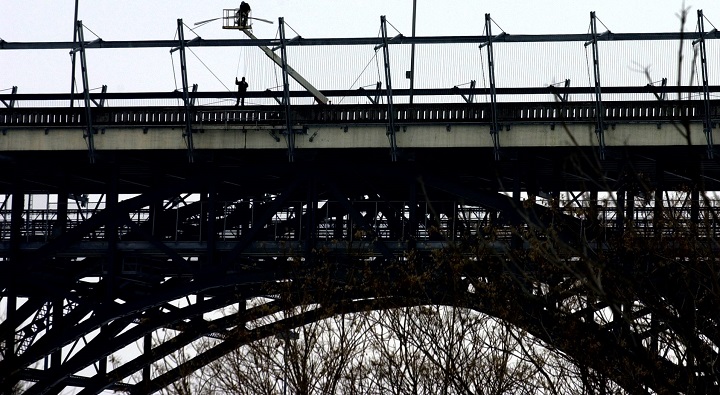TORONTO – A new study suggests a barrier erected on a Toronto overpass that was once the second-most frequented bridge for suicides in North America is serving its purpose.

The study from Sunnybrook Hospital, published in the journal BMJ Open on Tuesday, compares the 11-year periods before and after the barrier went up on the city’s Bloor Street Viaduct.
Researchers say an average of nine people a year had been dying by jumping from the bridge before 2003, placing it behind only San Francisco’s Golden Gate Bridge for suicides-by-jumping.
Since the barrier was put in place, however, the study found only one person has died by suicide at the site, a 485-metre overpass that spans a multi-lane highway, ravine and another major roadway.
READ MORE: These 3 groups are at ‘high risk’ of mental health issues in Canada. Here’s why
A previous report that examined data up to 2007 suggested suicide traffic had relocated to other nearby bridges, but the latest research suggests suicide rates across the city dropped over the long term after the barrier went up.
One of the study’s authors says the latest data is in line with other international research suggesting that barriers in key locations are effective.
“The barrier did have its intended effect,” study co-author Dr. Mark Sinyor of Sunnybrook said in a telephone interview.

Get weekly health news
“There was a decrease in deaths by jumping from bridges in Toronto by roughly the same number as the number that had previously been dying at the Bloor Viaduct, without an increase by other methods or locations.”
Sinyor said similar research has found the number of suicides-by-jumping at dozens of other sites with barriers in place have decreased noticeably.
At Edmonton’s High Level Bridge, for example, city statistics indicate the number of both suicides and general mental health calls was cut in half a year after barriers were installed in 2015.
Sinyor said the Bloor Viaduct was previously viewed as an outlier in the mental health community because of the results of the previous study. That report documented a sharp decline in the number of deaths at the bridge itself, but also tracked a spike in suicides at other locations.
READ MORE: 500,000 Canadians miss work each week due to mental health concerns
Researchers now attribute that finding to heavy media coverage in local print news outlets of deaths at the Bloor Viaduct and the debate as to whether or not the barrier was worthwhile. Sinyor said the connection was implied due to a slight increase in the number of general suicides within days or months of such coverage.
Over time, though, he said that effect has diminished. Suicide rates across the city have fallen due to a number of factors including the barrier, he said, crediting increased mental health supports, more open discussion surrounding stigma and heightened media sensitivity to such issues for a sharp decrease in recent years.
Average annual suicides in Toronto fell from 257 in the 11 years before 2003, to 234 in the 11 years after, according to the study.
READ MORE: Suicide and self-harm: Paige Willfong-Mackie shares her story
Sinyor said those numbers highlight the need for a wide complement of suicide prevention measures, a view shared by Mark Henick of the Canadian Mental Health Association.
He called for a national suicide prevention strategy as well as ongoing support for mental-health care.
He said the effectiveness of bridge barriers can even be enhanced by posting signs directing vulnerable people toward key resources and messages emphasizing that help is available.
“Suicide is preventable,” Henick said.
“When people get the help that they need, recovery is not only possible from mental health problems, it’s likely.”
Where to get help
If you or someone you know is in crisis and needs help, resources are available. In case of an emergency, please call 911 for immediate help.
The Canadian Association for Suicide Prevention, Depression Hurts and Kids Help Phone 1-800-668-6868 all offer ways of getting help if you, or someone you know, may be suffering from mental health issues.





Comments